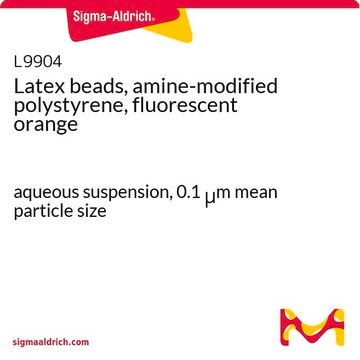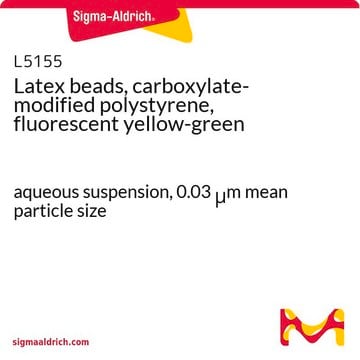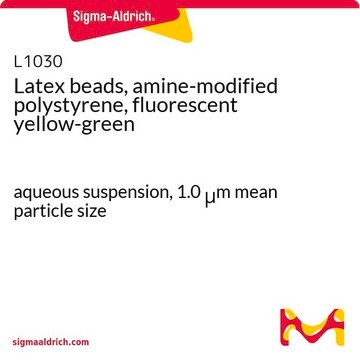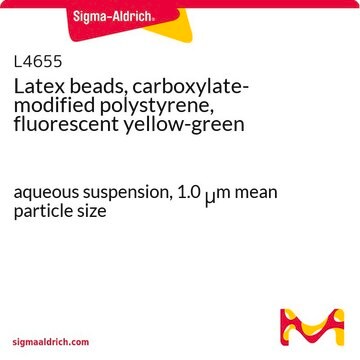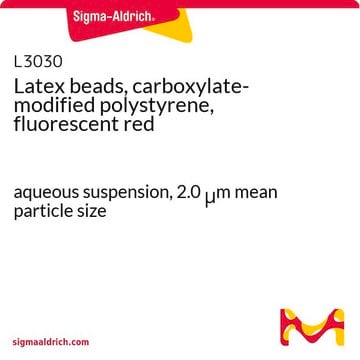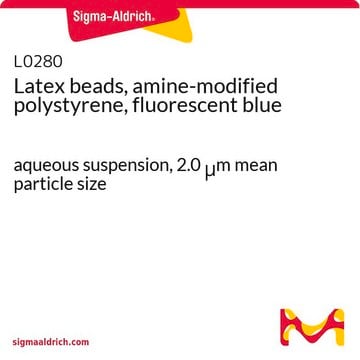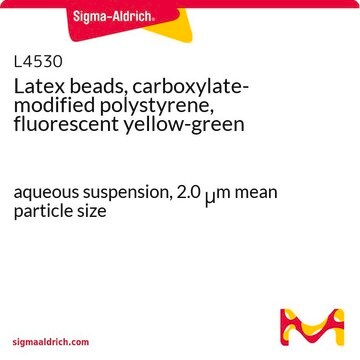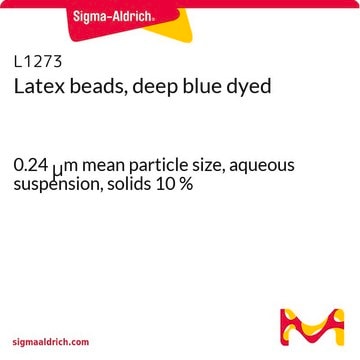L0780
Latex beads, amine-modified polystyrene, fluorescent blue
aqueous suspension, 0.05 μm mean particle size
Autenticatiper visualizzare i prezzi riservati alla tua organizzazione & contrattuali
About This Item
Prodotti consigliati
Forma fisica
aqueous suspension
Livello qualitativo
Composizione
Solids, 2.5%
tecniche
cell based assay: suitable
Dimens. media particelle
0.05 μm
Fluorescenza
λex ~360 nm; λem ~420 nm
applicazioni
cell analysis
Cerchi prodotti simili? Visita Guida al confronto tra prodotti
Applicazioni
Latex beads, amine-modified polystyrene, fluorescent blue has been used:
- to study its effects on the concentration-response relationship of bacterial cell viability
- in the preparation of nanoparticles
- as a model nanoparticle to study interactions with human blood and platelets
Azioni biochim/fisiol
Polystyrene latex beads can be used to create latex agglutination systems. Polystyrene latex beads have been used to study the transmission of Mycobacterium leprae, the causative pathogen of leprosy, as well as to develop a method for mass screening for both pulmonary and extrapulmonary tuberculosis.
Codice della classe di stoccaggio
10 - Combustible liquids
Classe di pericolosità dell'acqua (WGK)
WGK 3
Punto d’infiammabilità (°F)
Not applicable
Punto d’infiammabilità (°C)
Not applicable
Certificati d'analisi (COA)
Cerca il Certificati d'analisi (COA) digitando il numero di lotto/batch corrispondente. I numeri di lotto o di batch sono stampati sull'etichetta dei prodotti dopo la parola ‘Lotto’ o ‘Batch’.
Possiedi già questo prodotto?
I documenti relativi ai prodotti acquistati recentemente sono disponibili nell’Archivio dei documenti.
I clienti hanno visto anche
INDUCTION OF EPIGENETIC RESPONSE TO AMINO-MODIFIED POLYSTYRENE NANOPARTICLES IN HUMAN CELLS
Koprinarova M, et al.
Comparative clinical pathology, 71(10) (2018)
Catherine McGuinnes et al.
Toxicological sciences : an official journal of the Society of Toxicology, 119(2), 359-368 (2010-12-03)
There is evidence that nanoparticles (NP) can enter the bloodstream following deposition in the lungs, where they may interact with platelets. Polystyrene latex nanoparticles (PLNP) of the same size but with different surface charge-unmodified (umPLNP), aminated (aPLNP), and carboxylated (cPLNP)-were
Optical signatures of small nanoparticles in a conventional microscope.
Eann A Patterson et al.
Small (Weinheim an der Bergstrasse, Germany), 4(10), 1703-1706 (2008-09-10)
J Geys et al.
Toxicology letters, 160(3), 218-226 (2005-09-03)
Recent studies indicate that inhaled ultrafine particles can pass into the circulation. To study this translocation in an in vitro model three types of pulmonary epithelial cells were examined. The integrity of the cell monolayer was verified by measuring the
J-M Gineste et al.
Journal of microscopy, 243(2), 172-178 (2011-03-08)
The forward scattering of light in a conventional inverted optical microscope by nanoparticles ranging in diameter from 10 to 50nm has been used to automatically and quantitatively identify and track their location in three-dimensions with a temporal resolution of 200ms.
Il team dei nostri ricercatori vanta grande esperienza in tutte le aree della ricerca quali Life Science, scienza dei materiali, sintesi chimica, cromatografia, discipline analitiche, ecc..
Contatta l'Assistenza Tecnica.
